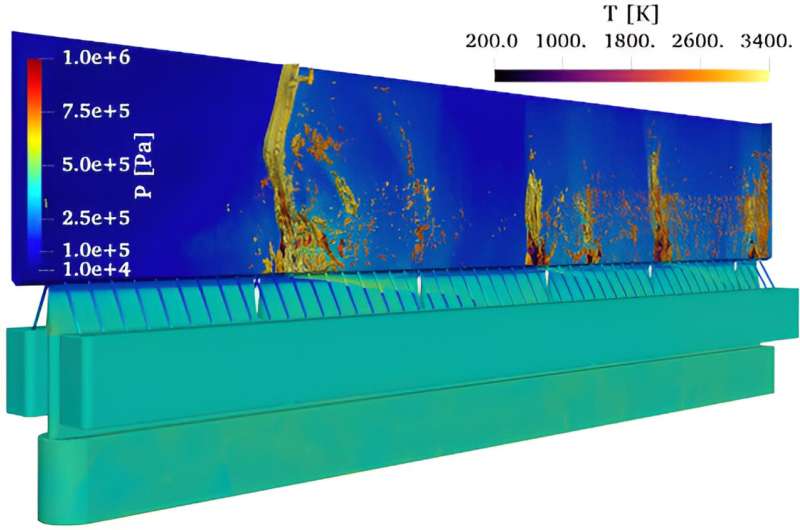
Combustors that drive propulsion systems are often volumetric in nature, typically in the form of cylinders, and convert chemical to thermal and mechanical energy through oxidation of fuels. This deflagrating combustion approach is now beginning to be challenged by detonation-based combustion that utilizes shock waves to accelerate the oxidation of fuel-air mixture.
This technology, originally studied at the University of Michigan in the 1960s and ’70s, is seeing a resurgence due to its unique characteristics that have found application in everything from power generation to hypersonic flight.
University of Michigan researchers, led by Michael Ullman, a graduate research assistant in the Aerospace Engineering department and Venkat Raman, a professor in the same department, along with collaborators at Purdue University and the Air Force Research Laboratory (AFRL), have studied a new form factor for such detonation-driven propulsion, allowing a linear array of injectors to sustain fast moving shock waves in a rectangular domain. It is the first time a linear combustor has been studied computationally at this level of detail, which has revealed the causal mechanism for detonation stabilization.
The research is published in the journal Combustion and Flame.
“This pan-flute look-alike technology has the potential to alter propulsion systems, including improvements in efficiency, enabling hypersonic flight regimes, and removing some of the design constraints associated with traditional combustion chambers,” said Venkat Raman, professor of aerospace engineering and mechanical engineering at U-M and contributing author. “For instance, the linear system could provide on-demand thrust for small aircrafts or drones or can be used to attitude control of flight systems.”
The key to studying this system computationally is to capture both the details of the shock wave and associated reaction layer as well as the geometric features. A detailed numerical simulation approach using a computational approach developed by Raman’s team was utilized. Experimental data was obtained by the Purdue University team, in collaboration with AFRL researchers. Validation of the simulations using the experimental data provided confidence in the conclusions from the study.
The device consists of a series of fuel and air injectors arranged linearly at the base of a rectangular box that is relatively thin. After the flow is ignited using a laser pulse, a propagating detonation wave is set up, which moves back and forth between the two walls of the rectangular chamber.
This shock wave travels at nearly 1.5 km/s and can generate very high power per unit volume of combustor. The gases are compressed by the shock wave and reacted, and then expanded towards the other end of the chamber, where they are exhausted to generate thrust.
“Detonation engines provide unique opportunities that are not being fully exploited yet. The goal here is to demonstrate novel applications that will showcase its advantages,” said Venkat Raman, professor in aerospace engineering and mechanical engineering at U-M and a co-author of the paper.
Additional co-authors include: Supraj Prakash of U-M; Deborah Jackson of Purdue University School of Aeronautics and Astronautics; Carson Slabaugh, associate professor of aeronautics and astronautics at Purdue University; and John Bennewitz, assistant professor in the Mechanical & Aerospace Engineering Department at the University of Alabama in Huntsville.
More information:
Michael Ullman et al, Self-excited wave stabilization in a linear detonation combustor, Combustion and Flame (2023). DOI: 10.1016/j.combustflame.2023.113044
Citation:
Detonation-based device for novel propulsion applications (2023, November 28)
retrieved 28 November 2023
from https://techxplore.com/news/2023-11-detonation-based-device-propulsion-applications.html
This document is subject to copyright. Apart from any fair dealing for the purpose of private study or research, no
part may be reproduced without the written permission. The content is provided for information purposes only.
Stay connected with us on social media platform for instant update click here to join our Twitter, & Facebook
We are now on Telegram. Click here to join our channel (@TechiUpdate) and stay updated with the latest Technology headlines.
For all the latest Technology News Click Here
For the latest news and updates, follow us on Google News.
